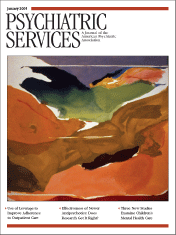January 2005: This Month's Highlights
Use of Leverage to Improve Treatment Adherence
Two studies reported in this issue of Psychiatric Services address the use of financial and other forms of leverage to encourage consumers to adhere to mental health treatment. In the first, John Monahan, Ph.D., and his coauthors studied the frequency of use of four types of leverage—money, housing, sanctions through the criminal justice system, and outpatient commitment—among 200 patients in the public mental health system in five states. One finding of the study was that leverage was used significantly more frequently among younger patients and those with more severe, disabling, and longer lasting psychopathology. Another important finding was that outpatient commitment, which is controversial and has received the most attention in the literature, was used the least often of the four types of leverage (see page 37). In the second study, Eric B. Elbogen, Ph.D., and colleagues interviewed 104 consumers with schizophrenia or a related disorder about their perceptions of representative payees' use of disability funds and other legal pressures to attempt to improve treatment adherence. One of the study's conclusions was that use of disability funds as leverage is most likely to be effective if it is combined with efforts to enhance patients' sense of self-determination (see page 45).
A Focus on Child Mental Health
Aspects of the mental health care of children and adolescents are the focus of three articles in this month's issue. E. Michael Foster, Ph.D., and Tim Connor, M.S., studied how improving community mental health services for youths by use of a system-of-care approach affects public expenditures on services for children and adolescents provided by the juvenile justice system, the child welfare system, and the special education system. Among their conclusions was that the costs of improving community mental health services for youths are only partly offset by associated reduced expenditures in the other sectors (see page 50). David S. Mandell, Sc.D., and his coauthors, in response to concerns about observed increases in the number of children who are receiving diagnoses of neurodevelopmental disorders, studied trends in diagnosis rates for autism and attention-deficit hyperactivity disorder at hospital discharge in the context of other psychiatric diagnoses (see page 56). Finally, Kim D. Jaffee, Ph.D., M.S.W., and associates interviewed 257 low-income caregivers of children with special health care needs to assess the relationship of community-level stressors to behavioral and emotional problems among African-American and white children with such needs (see page 63).
Haloperidol: A Fair Comparator Without Anticholinergics ?
In what is sure to be a controversial Open Forum piece, Robert A. Rosenheck, M.D., asks whether the use of haloperidol without prophylactic anticholinergics is a fair comparator in studies evaluating second-generation antipsychotics. Last year, Dr. Rosenheck and his colleagues published the results of a Department of Veterans Affairs (VA) Cooperative Study comparing olanzapine and haloperidol that unexpectedly found far more limited benefits for olanzapine than had been reported in other studies, apparently because anticholinergic medication had been prescribed to the haloperidol group prophylactically rather than as needed, which reduced discontinuation of treatment in the VA study. After reviewing dozens of previous studies, Dr. Rosenheck presents his current understanding of the issue for Psychiatric Services readers (see page 85).
Effects of the SARS Outbreak on Health Care Workers
Severe acute respiratory syndrome (SARS) has become a major international public health problem, generating considerable fear among members of the public and health care workers alike. At the peak of the outbreak in 2003, most SARS cases involved hospital-acquired infections. One Hong Kong study reported that as many as half the documented cases involved health care workers. In a timely study that is likely to be of interest to all health care professionals, Cheng-Sheng Chen, M.D., and colleagues determined the extent of psychological distress experienced by nurses at a community hospital in Taiwan who were working during the SARS crisis, particularly among those who were conscripted to work in higher-risk units because of staff shortages (see page 76). In a related Taking Issue piece, Robert J. Ursano, M.D., discusses the mental health sector's preparedness not just for SARS outbreaks but also for influenza and potential bioterrorist attacks (see page 7).
Briefly Noted …
•The Law & Psychiatry column examines the emergence of behavioral genetics as a factor in criminal proceedings (see page 25).
•A report on the 2004 Institute on Psychiatric Services highlights current issues in public-sector psychiatry (see page 16).



